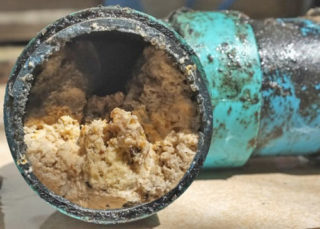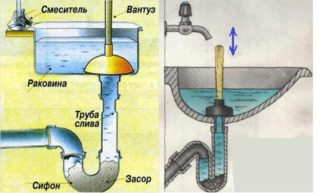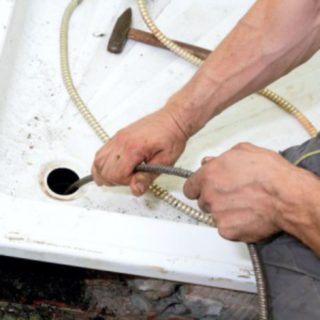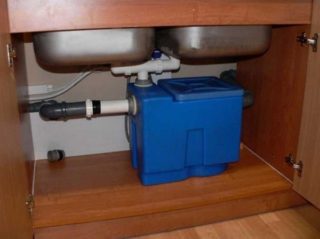Many housewives in their lives faced the problem of obstruction of sewer pipes. The fat gradually remains on the pipe walls. In addition, a variety of food waste particles are added to it. All this in general violates the permeability in the pipes. In this regard, many people are interested in the question: how is it possible to cleanse their pipes from fat and deposits.
Why is the formation of fatty deposits dangerous?
A variety of microorganisms and fungi develop and multiply in the fatty deposit located on the pipes. In the course of their vital activity, microorganisms and fungi secrete mucus, which is also located on the inner walls of the sewer pipes.
As a result of all of the above, an unpleasant smell of something rotten begins to spread from the pipes, rotten. This suggests that harmful bacteria are actively developing and living in your pipes. Needless to say, how dangerous it is for the health of people living in the apartment. Such a source of infection should not be left in the apartment. Not only is it not hygienic, but it can also be harmful and dangerous.
To do this, it is worthwhile to timely clean the pipes from deposits of fats and various food debris.
Fat Removal Methods
There are several ways through which you can clean the sewer pipes from grease. All methods are divided into chemical, mechanical, physical and thermal.
Now we will talk in more detail about mechanical methods of cleaning pipes. These include:
- plunger;
- plumbing cable;
- spiral machine.
Let's take a closer look at each of the methods.
Ventuz
- It is necessary to cover the drain with a plunger.
- Fill the sink with water.
- Make several movements with this device without lifting it from the drain.
How can you understand that even a not very experienced person in this matter can cope with the instructions for using the plunger.
If your pipe is not very clogged, then a plunger will quickly help solve your problem. If the blockage is too deep and far away, or if the pipe is heavily clogged, the plunger will not help you much.
Plumbing cable
First, you need to understand how deep the blockage is. To do this, you must first pour out all the water, if there is any in the sink.Then pour water into a clean (no water) sink and determine how far the blockage is located.
Procedure for cleaning the sewer pipe with a rope:
- Unscrew the drain and siphon.
- The end of the cable must be inserted into the pipe and pushed inward with slow scrolling movements.
- When the cable reaches the blockage, you need to make more effort to pierce it.
After the plumbing cable begins to move completely freely again, you will need to start pulling it out. This is also done slowly with scrolling movements. Must have in view ofthat there may be debris at the end of the cable. It is recommended that you take care of where you put it in advance.
After you have completed all the work, you need to rinse the cable and lubricate it with machine oil. And the pipes must be spilled with hot water.
Spiral machine
There is a special spiral at the end of the spiral machine. How does it work? Instructions for using the spiral machine:
- It is necessary to insert the machine into the pipe.
- In this case, the spiral begins to spin, first in one direction, then in the other. As a rule, in most cases, this method can quickly and easily clear the blockage in the sewer pipe. But this method is more expensive in cost than those that we have discussed above.
Some experts recommend using just a spiral instead of a machine. It must be moved in the same way along the pipe until it stops in the blockage, and then back.
This method of cleaning sewer pipes is very difficult to implement. Not every person will be able to cope with such a task using this equipment. But today, cleaning blockages with a spiral machine is considered one of the most effective.
A plumbing cable and a spiral machine are good at helping to clean the pipes if the cause of the blockage is any object or food debris that has accumulated on the walls.
Preventing the problem
One of the most important conditions for the water drain to work perfectly is the correct installation of the pipes. They must be correctly positioned at the right angle. It is also important to choose the right pipe diameter. By observing these conditions, you will improve the permeability of your pipes. Grease and food debris will drain well with the water through the pipes. The likelihood of food remaining on the side of the pipeline will be reduced.
You can use the following preventive measures:
- Try not to drain grease from pans and other utensils into pipes. It is advisable to pour it into one container and just throw it away with garbage. If you are not ready for such actions, then you can try to drain the fat down the toilet. Since the pipes in the bathroom are wider and the likelihood of blockage is less.
- It is recommended to flush the sewer pipes with plenty of hot water once a week.
- Use a cleaning agent for grease deposits on the pipe walls once a month. To do this, you need to take four tablespoons of baking soda and pour them into the pipe. Then pour a glass of boiling water or vinegar there. If you choose vinegar, you will need to cover the drain with a lid. The baking soda in combination with acetic acid will begin to form a foam that will come out of the pipe to the outside. You will need to wait 15 minutes and pour 2 liters of boiling water next.
- Try to make it a habit every time you do a general cleaning in your kitchen, to sleep a bag of special anti-blockage powder. You can do this on purpose at night.Enough time will pass, and the product will clean the sewer pipes well, kill germs and remove the mucus that has appeared. How often this procedure needs to be done depends on how much piping you use. Experts recommend carrying out such preventive work once every 1-3 months. The more often such actions are performed, the better the result will be.
- Install a dedicated shredder waste disposer... It will also reduce the chances of blockages in your pipes to some extent.
- Installing a grease trap will save you from the problem of fat deposition on the walls of the sewer pipes almost once and for all. In the simplest version, the grease trap is a two-section container. It is there that the stratification of water into a liquid and fat phase occurs. Today, the market offers a huge selection of these household appliances. Their service life is calculated for 25 years!













